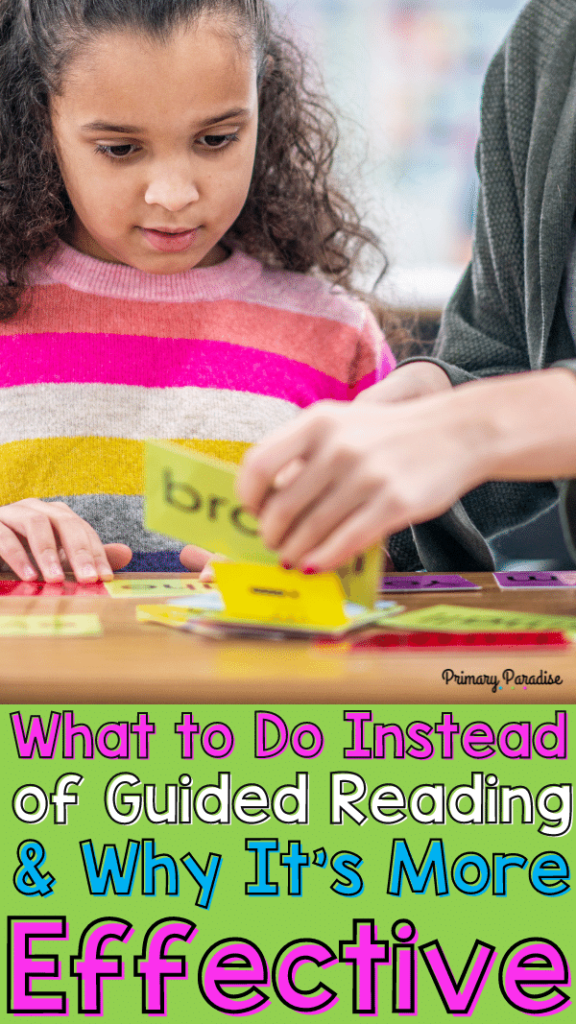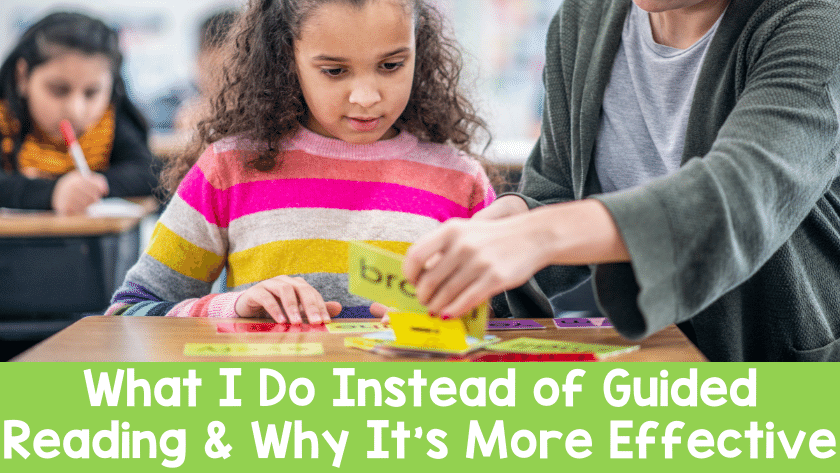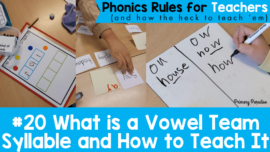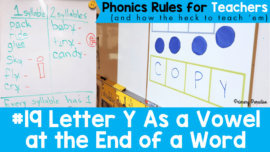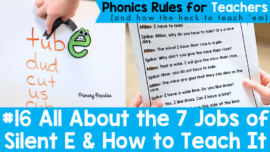Guided reading is under the microscope right now with the rise of the science of reading, and for good cause (but we’ll get to that). Can I tell you a secret about small group reading instruction? In my entire teaching career (and I pre-date Pinterest), I have never done traditional guided reading. Never. So, here’s what I do instead of traditional guided reading and why I believe it’s more effective.
Why Not Guided Reading?
My first school was a bit behind the curve with reading instruction. I didn’t actually start reading centers or more individualized reading instruction until my second year of teaching. And, at the time, I was the only teacher at my school teaching reading that way. When I began reading about and researching reading centers, daily five, and guided reading, there was a lot I liked. I loved the idea of building a love of reading and giving children choice and independence. However, the idea of guided reading didn’t make sense to me.
Traditional guided reading, where you pull a group of students on the same “level” and then have them read the same book or practice the same skills together, seemed illogical. Just because they’re all reading books on X level (remember, this was back when DRA and F&P were king), didn’t mean that they all needed to work on the same skills. So, I decided to keep looking for other, small group, individualized instruction options.
What Can You Do In Place of Traditional Guided Reading
What I found over the years is that there are many other options for small group reading instruction other than traditional guided reading. Here are the things I have done instead and why each one is effective.
Strategy Groups In Place of Guided Reading
The first thing that I tried with my students in place of traditional guided reading was to use strategy groups. If you’re familiar with the Daily 5 CAFE, than you know what strategy groups are. (In other words, I didn’t develop this idea myself.) If you aren’t familiar, this is how strategy groups work.
Instead of working with small groups based on their reading level, I based reading groups based on the particular skill that students were working on at that time. This means that the groups included students who were all in different places in their reading journey. Some might be reading chapter books, and others might be reading simple picture books. What they are reading doesn’t matter. All that matters is that they’re all focusing on the same skill. CAFE skills are comprehension , accuracy, fluency, and expanding vocabulary. These are the skills that I focused on.
I would have each student bring the book they were currently reading. I’d start by having them all read their book out loud for 2-3 minutes. I would take about 30 seconds to tune in to each student and listen to their reading. I’d take notes on what I noticed, and then ask all of them to stop reading. Depending on the skills, we’d take about 10 minutes for a mini lesson, discussion, or activity related to the skill. Then, students would go back to their center and I would meet with another group. In some ways this worked well, but in some ways, it missed the mark. My students made a lot of growth and they really loved that their groups were fluid. On the other hand, I still felt like the instruction wasn’t as targeted as it could be.
Still, I believe that this was more effective than guided reading because we were able to spend time focusing on developing specific reading skills. With traditional guided reading, instruction is based on a reading level. Recently there has been a lot of scrutiny on reading levels because they aren’t an accurate representation of where students are with their reading. Even if the levels were accurate, the reason a student is reading on that level can vary. One might need to work on decoding, one might be struggling with comprehension, one might really need to focus on vocabulary. To some extent, strategy groups were able to target areas of need more thoroughly than traditional guided reading.
One on One Reading Check Ins Instead of Guided Reading
At the same time I was using strategy groups, I also took one center round each day to do one on one reading check ins. This ensured that I could check in with every child at least once a week. I would come around and sit down with my students as they were reading.
First, I would just listen to them and take quick notes. Then, I’d vary what happened next based on what I was hearing. Maybe I would ask them some comprehension questions, maybe we would grab a white board and do a quick mini lesson on a sound that I noticed them struggling with, or, if the book seemed too hard or far, far to easy, we might review just right books. (Side note: I don’t mind my students reading books that are “too easy” at all as long as they also have a book or two that challenges them as well.)
No matter what, my students were able to receive on the spot, relevant reading instruction for right where they were. Oftentimes we would set a goal or a plan for our next check in. I’d make a note, and it would keep us both accountable.
By far, one on one reading check ins are my absolute favorite substitute for guided reading. Even if students are focusing on the same skill, we might need to tackle it a different way. Even if the same students are working on short vowel sounds, they might not need to work on the same short vowel sounds, or practice the same way. One on one check in are a quick and effective way to touch base with your students continually on their reading journey. This is still the method I prefer to this day.
Phonics Focused Reading Groups Instead of Guided Reading
Since I began to research and understand the science of reading, I’ve opted to move away from strategy groups. This is because skills like comprehension and vocabulary work well with whole class read alouds where we can take decoding out of the equation. I can help my students with accuracy and fluency with one on one checks. Instead, if I am going to work with a small group, now I will work on students based on what phonics sounds they are working on.
Instead of pulling students based on being on level 3 or d or whatever arbitrary leveling system, I will make groups based on the phonics skills they have mastered and which ones they still need to focus on. This allows me to help my students who are focusing on short vowels, or cvc words, or digraphs build on the skills they already have. It also allows me to push my higher students even further. Grouping students this way, and then using science based, hands on activities is much more effective than traditional guided reading since strong decoding skills are the foundation of everything else.
So, What Do I Do Now Instead of Guided Reading?
At this time, I use phonics focused reading groups, in combination with consistent whole group instruction and one on one check ins. I believe this is far more effective then traditional guided reading. Is it perfect? No. I still notice gaps, and have students who need more. I am still learning and growing. But, I believe that as long as we continue to move towards what works and away from things we do “just because” the more our learners will benefit.
Keep reading and learning:
Free Word Work Support Guide for Parents
5 Ways to Help Reluctant Readers Enjoy Reading
Graphic Novels for Grades 1 and 2
How to Boost Your Students’ Reading Confidence
